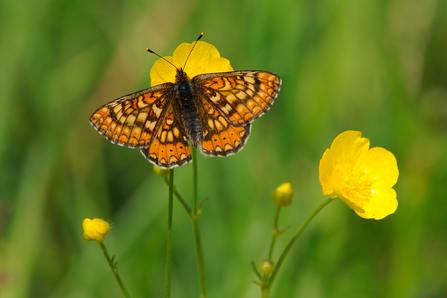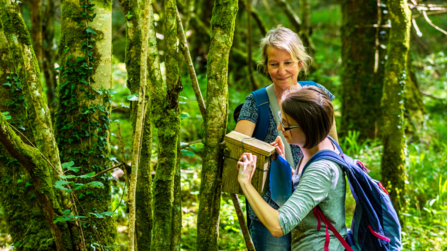7 minute read
COP15 takes place from 7th – 19th December. In this simple guide, we explain all the basics you need to understand about COP15… and what makes it important for Cornwall and our world.
7 minute read
COP15 takes place from 7th – 19th December. In this simple guide, we explain all the basics you need to understand about COP15… and what makes it important for Cornwall and our world.
‘COP’ means ‘Conference of the Parties’… and this one is on biological diversity, but we’ll come to what it means later.
15 simply refers to the fact that this is the fifteenth meeting of the Parties to the Convention on Biological Diversity (CBD), since it was launched at the Earth Summit in 1992. However, this one is important as countries haven’t met for several years due to the COVID-19 pandemic.
You could be forgiven for asking, ‘Haven’t we just had a COP?!’ Well, yes, we have. It’s alright if you’re a little confused – it might feel like déjà vu. But you’re probably thinking about COP27, which took place in Sharm el-Sheikh between 6th – 18th November 2022.
COP15 starts on 7th December and will last for two weeks. It will be held in Montreal, Canada, but China will host it, as they would have done so if it were not for the pandemic.
COP27 was a United Nations (UN) climate summit, which is a Conference of the Parties of the UN Framework Convention on Climate Change (UNFCCC). They're held every year for governments to agree – or at least try to agree – how they’re going to tackle global temperature rises. You can read more about the outcomes of COP27 here.
COP15, on the other hand, is similar, but will focus on nature. It’s about finding strategies to stop biodiversity loss.
As we noted above, COP15 is a meeting of the parties to the Convention on Biological Diversity (CBD). This was a global agreement on nature conservation, which sets out guidelines for countries to protect biodiversity. The CBD has been adopted by over 190 UN member states.
Both CBD and UNFCCC were borne out of the Rio Earth Summit in 1992. Of course, biodiversity and climate change are inextricably linked, so it is impossible to see these two areas completely in isolation.
Find out more about the outcomes of COP27
Biodiversity is all about the variety of life found in a place on the Earth. So, biodiversity loss is when there is a decrease in this variety of life. Some species - including birds, butterflies, insects and corals - are getting increasingly rare, while others are becoming extinct. This can be caused by a range of factors such as pollution, intensive farming, overfishing, climate change, or habitat loss.

Marsh Fritillary Butterfly, Image by Amy Lewis
First, it matters because COP15 has been delayed for two years, so this is a key moment in trying to halt the destruction of the natural world.
Second, previous targets – agreed at COP10 in Aichi, Japan – have not been met. This means that the new targets for 2030 which will be decided at COP15 are vital. And these targets need to be turned into more than empty words and lead to decisive action.
The conference comes at a time when the latest study suggests the Earth’s wildlife has plummeted by almost 70% in the last 50 years. In addition, recent Government actions threaten to make a bad situation even worse. This will diminish the UK’s power to negotiate.
The loss of biodiversity is vitally important – not only for the intrinsic value of wildlife, but also for human survival. Interactions between plants, fungi and animals are interlinked with the food we eat and the medicines we rely upon.
The UK is one of the most nature-depleted countries in the world – and in Cornwall, wildlife has suffered over recent decades for a number of reasons. Between 2002-2019, Cornwall’s human population grew by almost 13%, leading to more development. Consumer demand has meant that much of Cornwall’s farmland – 75% of Cornwall – has been farmed more intensively. Climate change means the average temperature in the county has increased by nearly 1°C in last 35 years.
These – and many other factors – have led to a worrying decline in wildlife in Cornwall over the last 30 years. Since the 1970s there is evidence that 21 breeding birds, 4 vascular plants, and 8 bumblebees have become extinct in Cornwall.
These concerning statistics are drawn from Cornwall Wildlife Trust’s first State of Nature Cornwall Report from 2020, which was made using the best available data for local wildlife. Together with Cornwall Council and the University of Exeter, we highlighted trends in the abundance and distribution of species and habitats and identified the key pressures wildlife is facing.
The report concludes that ‘nature is in decline in Cornwall. Over the last 30 years, nearly half of terrestrial mammals and three-fifths of butterflies are found in fewer places... Whilst a few species have prospered, it is clear that an ecological emergency is unfolding.’
In other words, despite Cornwall’s beauty and wild landscapes, it is abundantly clear that Cornwall is in no way immune from the global trends we are witnessing in biodiversity loss.
Together with other Wildlife Trusts across the UK, we want to see bold action to tackle both the nature and the climate crises. We want to see 30% of land and sea protected for nature by 2030; we hope to see COP15 agree a landmark legally-binding global treaty to halt and reverse the loss of biodiversity by 2030.
Just as the landmark Paris Agreement was set in 2015 at COP21 to limit global warming to below 2 degrees, we want COP15 to agree a similar treaty on nature. This would ensure leaders across the world have to take action on nature as a priority this decade.
And if the UK wishes to be a world leader, we want to see the Government take the following action:
If you have made it this far reading this blog – thank you: you have already taken an important action for nature! In order to act for nature, we need to educate ourselves.
One of the most important actions you can take is to raise your voice to #DefendNature….
And if you haven’t already, you can also join the movement.
At Cornwall Wildlife Trust, our staff and volunteers are on the ground working hard to reverse the decline in nature every day here in Cornwall – thanks to the support of our members and funders.
We manage 59 nature reserves across Cornwall, which contain rare and important habitats for wildlife and carbon capture, helping tackle the climate and ecological crisis we face. We aim to increase the size of our reserves and work with neighbouring landowners to encourage a bigger, better, and more joined-up network for nature.

Volunteers checking dormouse boxes at Cornwall Wildlife Trust's Cabilla & Redrice nature reserve. Image by Ben Watkins
Our team works every day to restore 30% of Cornwall’s land for nature by 2030. With more than 70% of Cornwall being used to produce our food, we are working collaboratively with farmers to bring nature back.. Our specialist staff of farm advisers work to build relationships with farmers from across Cornwall, offering in-depth knowledge of current legislation and best practice management of specialist species.
Cornwall’s coast is home to some of the richest marine wildlife, from tiny rare colourful corals to bottlenose dolphins and giant basking sharks. However, this diverse marine life urgently needs protecting. As with our work on land, at Cornwall Wildlife Trust we’re working hard to restore 30% of Cornwall’s land for nature by 2030 and have a wide and varied range of marine projects. We monitor our marine environment, creating awareness of the threats to marine life and campaigning for better protection for our marine species and habitats.